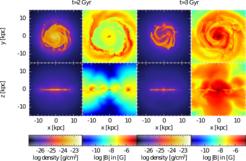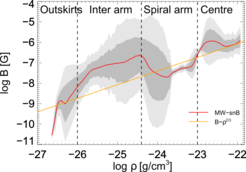Dynamo-amplification and magnetic driven outflows in Milky Way-like galaxies

Figure 1: These views show the galaxy in a simulation where the magnetic field is seeded into the ISM with each supernova that occurs. The top and bottom rows show face-on and edge-on views, respectively, with gas density (first and third column) and magnetic field strength (second and fourth column) shown at two different times in the evolution of the galaxy. At 2 billion years (first and second column), thermal pressure is dominating in the galactic disc and outflows due to the magnetic field are not possible. At 3 billion years, the magnetic pressure is dominating and magnetic outflows are possible, which are happening in two cones perpendicular to the disc. Although these cannot be very well identified in the gas-density itself, they can be seen in the magnetic field strength as two lobes above the disc.
Magnetic fields can be important for many physical processes in galaxy formation and evolution; yet it is poorly understood how magnetic fields change this picture. In galaxies with halo masses above 10 billion solar masses they can be quickly amplified from a small seed field to a few µG in the galactic disc. In this scenario there are three main amplification processes for magnetic fields: adiabatic compression, the so called α-ω-dynamo, and the small-scale turbulent dynamo. Once magnetic fields are amplified via one of these three processes they have the ability to launch a galactic wind if the magnetic pressure is in the same order of magnitude (or higher) than the thermal pressure.
Amplification via adiabatic compression is an effect of ideal magneto hydrodynamics (MHD), which is caused when the gas in the centre of a dark matter halo collapses, leading to compressed field lines and therefore an amplification of the magnetic field. In this case the magnetic field strength and the density are correlated by a simple power law relation (B ~ ρ2/3). The α-ω-dynamo can amplify magnetic fields in both the linear and the non-linear regime through small-scale buoyant flows (alpha-effect) and large-scale rotation of the disc (omega-effect). The small scale turbulent dynamo can lead to linear and non-linear amplification of the magnetic field due to turbulence in the interstellar medium (ISM). In this case, the turbulence is introduced by supernova-feedback, leading to a similar behaviour as for the α-ω-dynamo (but different physical origin). However, both effects can be clearly distinguished through their respective power spectrum. If both dynamo processes are acting simultaneously the net effect is called α2-ω-dynamo.

Figure 2: Bi-conical outflow in the magnetic field shortly after its onset at 2.4 billion years in the simulation; the outflow appears in both magnetic field models. The outflow is very prominent in the magnetic field strength, reaching values of up to a few 10 µG, which is comparable with values observed for the Fermi-bubbles reaching far into Milky Ways’ CGM. In terms of morphology and velocity, the outflow structure is closer to a wind that is driven by an active galactic nuclei (AGN) rather than driven by stellar feedback.
A team of researchers from the astronomical Max Planck Institutes in Garching, the University Observatory in Munich and the University of Konstanz have carried out high resolution simulations of isolated Milky Way-like galaxies to study the details of these dynamo processes and the consequences of magnetic driven outflows on the general properties of the galaxy. The research team introduced a new galactic model for isolated galaxies including a hot circum galactic medium (CGM) around the central disc, embedded in a dark matter halo. This provides a more realistic framework to model inflows from the hot CGM and effects of magnetic fields can be studied with the Tree-Smooth-Particle-Magneto-Hydrodynamics-(SPMHD)-code Gadget-3.
Moreover, the team investigated the impact of different initial conditions for the magnetic field. The fiducial model is the so called ‘supernova-seeding model’, in which the magnetic field is given to the ISM in a dipole structure with every exploding supernova. This model assumes that magnetic fields are generated in stars via dynamo action. The alternative model postulates a (small) constant seed field parallel to the disc, assuming that such small seed-fields are generated before inflation and get further amplified during inflation.
The research team finds a magnetic outflow perpendicular to the galactic disc in two cones that reduces the star formation rate substantially. At the end of the simulation (4 Gyr), the star formation rate is roughly half compared to a run without magnetic fields. Further, the mass of the disc is slightly reduced with outflows carrying away between 0.2 and 1.0 solar masses per year. For both magnetic field models the magnetic field strength saturates at a few µG in agreement with observations. The morphology of the simulated galaxy with the fiducial model is displayed in Fig.1. The biconical shape of the outflow is displayed in Fig.2.

Figure 3: Median magnetic field strength for the simulation with supernova seeding (red) as well as the 1σ (dark gray region) and 2σ (light gray region) errors. The orange line shows a relation known from magneto-hydrodynamics theory, indicating amplification by adiabatic compression. The highest magnetic field strengths correlate with the highest gas densities.
In the centre the amplification of the magnetic field is driven by both adiabatic compression and small scale turbulence. In the spiral arms the magnetic field is lower and is mainly amplified by adiabatic compression. The magnetic field strength in the inter arm regions, i.e. the less dense areas between the spiral arms, shows a higher magnetic field than could be explained by adiabatic compression. Here the magnetic field is amplified by small scale turbulence. In the outskirts of the galaxy the amplification is not driven by adiabatic compression because the simulation is not following the scaling law known from ideal MHD.
The amplification process of the magnetic field is complicated, but the research team was able to find strong evidence for an α2-ω-dynamo for early times which transfers to an ordinary α-ω-dynamo at late times when the amplification by small-scale turbulence is suppressed by declining supernova-rates and strong magnetic fields that further supress turbulence in the ISM. Further, the research team could identify different regions within the galactic disc to evaluate the contribution to the amplification of the magnetic field by adiabatic compression (Fig. 3).
For the first time with a particle based method, the research team was able to show that their simulations agreed both with predictions from dynamo theory and with observations of magnetic fields in nearby galaxies. They were able to recover the observed saturation field strengths after a non-linear growth phase of the magnetic field in the simulation. Further, they were able to reproduce the observed morphological appearance of galactic magnetic fields that did not appear in other numerical simulations of the same kind.














